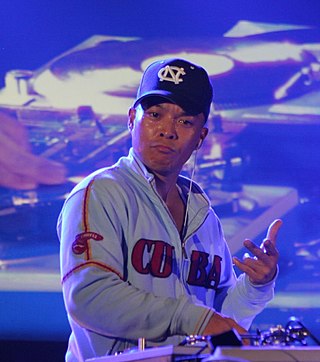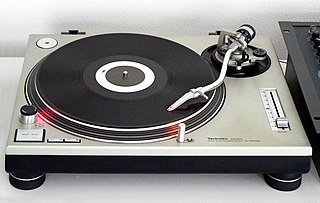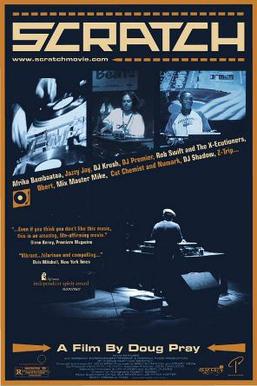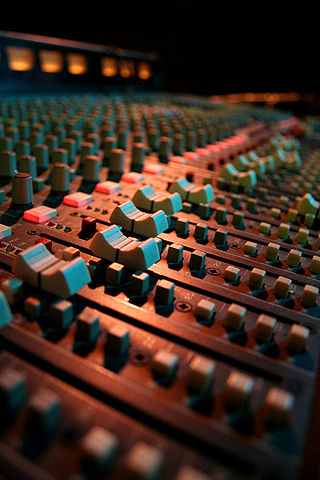Related Research Articles

Beatmatching or pitch cue is a disc jockey technique of pitch shifting or time stretching an upcoming track to match its tempo to that of the currently playing track, and to adjust them such that the beats are synchronized—e.g. the kicks and snares in two house records hit at the same time when both records are played simultaneously. Beatmatching is a component of beatmixing which employs beatmatching combined with equalization, attention to phrasing and track selection in an attempt to make a single mix that flows together and has a good structure.

A disc jockey, more commonly abbreviated as DJ, is a person who plays recorded music for an audience. Types of DJs include radio DJs, club DJs, mobile DJs, and turntablists. Originally, the "disc" in "disc jockey" referred to shellac and later vinyl records, but nowadays DJ is used as an all-encompassing term to also describe persons who mix music from other recording media such as cassettes, CDs or digital audio files on a CDJ, controller, or even a laptop. DJs may adopt the title "DJ" in front of their real names, adopted pseudonyms, or stage names.

A mixing console or mixing desk is an electronic device for mixing audio signals, used in sound recording and reproduction and sound reinforcement systems. Inputs to the console include microphones, signals from electric or electronic instruments, or recorded sounds. Mixers may control analog or digital signals. The modified signals are summed to produce the combined output signals, which can then be broadcast, amplified through a sound reinforcement system or recorded.

Scratching, sometimes referred to as scrubbing, is a DJ and turntablist technique of moving a vinyl record back and forth on a turntable to produce percussive or rhythmic sounds. A crossfader on a DJ mixer may be used to fade between two records simultaneously.

Turntablism is the art of manipulating sounds and creating new music, sound effects, mixes and other creative sounds and beats, typically by using two or more turntables and a cross fader-equipped DJ mixer. The mixer is plugged into a PA system and/or broadcasting equipment so that a wider audience can hear the turntablist's music. Turntablists typically manipulate records on a turntable by moving the record with their hand to cue the stylus to exact points on a record, and by touching or moving the platter or record to stop, slow down, speed up or, spin the record backwards, or moving the turntable platter back and forth, all while using a DJ mixer's crossfader control and the mixer's gain and equalization controls to adjust the sound and level of each turntable. Turntablists typically use two or more turntables and headphones to cue up desired start points on different records.

A direct-drive turntable is one of the three main phonograph designs currently being produced. The other styles are the belt-drive turntable and the idler-wheel type. Each name is based upon the type of coupling used between the platter of the turntable and the motor.

Beatboxing is a form of vocal percussion primarily involving the art of mimicking drum machines, using one's mouth, lips, tongue, and voice. It may also involve vocal imitation of turntablism, and other musical instruments. Beatboxing today is connected with hip-hop culture, often referred to as "the fifth element" of hip-hop, although it is not limited to hip-hop music. The term "beatboxing" is sometimes used to refer to vocal percussion in general.

Richard Quitevis known by his stage name DJ Qbert or Qbert, is an American turntablist and composer who has heavily influenced the History of DJing. He was awarded America's Best DJ in 2010, was DMC USA Champion 1991 (solo) and achieved titles as DMC World Champion in 1992 and 1993.

Scratch is a 2001 documentary film, directed and edited by Doug Pray. The film explores the world of the hip-hop DJ from the birth of hip-hop when pioneering DJs began extending breaks on records, to the invention of scratching and beat juggling, to the more recent explosion of turntablism. Throughout the documentary, many artists explain how they were introduced to hip-hop while providing stories of their personal experiences.
The Invisibl Skratch Piklz are an American group of turntablists.

In audio engineering, a fade is a gradual increase or decrease in the level of an audio signal. The term can also be used for film cinematography or theatre lighting in much the same way.

The X-Ecutioners, originally known as X-Men, are a group of American hip hop DJs/turntablists from New York City, New York. The group formed in 1989 and currently consists of three DJs, including Total Eclipse, DJ Boogie Blind, and DJ Precision. Original members of the group included Mista Sinista, Rob Swift, and Roc Raida. Rob Swift and Total Eclipse formed a side project called Ill Insanity releasing one album together in 2008 entitled Ground Xero.

Michael Schwartz, better known by his stage name Mix Master Mike, is an American turntablist best known for his work with Beastie Boys.

A DJ mixer is a type of audio mixing console used by disc jockeys (DJs) to control and manipulate multiple audio signals. Some DJs use the mixer to make seamless transitions from one song to another when they are playing records at a dance club. Hip hop DJs and turntablists use the DJ mixer to play record players like a musical instrument and create new sounds. DJs in the disco, house music, electronic dance music and other dance-oriented genres use the mixer to make smooth transitions between different sound recordings as they are playing. The sources are typically record turntables, compact cassettes, CDJs, or DJ software on a laptop. DJ mixers allow the DJ to use headphones to preview the next song before playing it to the audience. Most low- to mid-priced DJ mixers can only accommodate two turntables or CD players, but some mixers can accommodate up to four turntables or CD players. DJs and turntablists in hip hop music and nu metal use DJ mixers to create beats, loops and so-called scratching sound effects.

Vestax Corporation was a Japanese musical instrument, turntable and audio equipment firm founded by Hidesato Shiino in 1977. The company started by designing and manufacturing electronic guitars. In the 1980s, Vestax produced multitrack recorders and later moved to making DJ mixers, professional turntables, CD players and signal processors. Debt troubles led to the company's bankruptcy at the end of 2014.
A DJ mix or DJ mixset is a sequence of musical tracks typically mixed together to appear as one continuous track. DJ mixes are usually performed using a DJ mixer and multiple sounds sources, such as turntables, CD players, digital audio players or computer sound cards, sometimes with the addition of samplers and effects units, although it is possible to create one using sound editing software.
DJ Disk is a turntablist from the San Francisco Bay Area. He is of Panamanian, Colombian, and Nicaraguan descent. Born Luis Quintanilla on October 7, 1970, in San Francisco, Disk began scratching and mixing vinyl at a young age. In 1992, he joined his long-time friend DJ Qbert among the Rock Steady Crew DJs, later changing the group's name to the Invisibl Skratch Piklz.
Turntablist Transcription Methodology, or TTM, is a notation system for scratching and turntablism. The system was founded by John Carluccio in 1997. A seminal booklet detailing the system was written and published by John Carluccio, industrial designer Ethan Imboden and DJ Raedawn in 2000. It is an intuitive graphical representation of the movement of a record whilst performing with a turntable, and was originally documented in a booklet form for distribution used by turntablists around the world.

DJ Hero is a 2009 rhythm game developed by FreeStyleGames and published by Activision. It is the first spin-off of the Guitar Hero series. It was released on October 27, 2009, in North America and on October 29, 2009, in Europe. The game is based on turntablism, the act of creating a new musical work from one or more previously recorded songs using record players and sound effect generators, and features 94 remixes of two different songs across numerous genres.

Controllerism is the art and practice of using musical software controllers, e.g. MIDI, Open Sound Control (OSC), joystick, etc., to build upon, mix, scratch, remix, effect, modify, or otherwise create music, usually by a Digital DJ or Live PA performer, often called a controllerist. Controllerism is also a nod to traditional musicianship and instrumental-ism paired with modern computer sequencing software such as Ableton Live and Native Instruments Traktor. However a working knowledge of scales and chords is not necessarily required as the performers typically focus their efforts more on sequencing events, software effect and instrument manipulations using buttons, knobs, faders, keys, foot switches and pedals than on instrumental notes played in real time. With recent developments in music technology, particularly in software instruments, a USB MIDI controller enables musicians almost unlimited possibilities to control a wide variety of sound types.
References
- 1 2 "Scratching for Beginners" . Retrieved 2024-06-24.
- ↑ "The Origins of the Crab Scratch" . Retrieved 2024-06-24.
- ↑ "Fun Facts About DJ Qbert" . Retrieved 2024-06-24.
- ↑ "Secrets of the Crab Scratch" . Retrieved 2024-06-24.
- ↑ "Mastering the Crab Scratch" . Retrieved 2024-06-24.